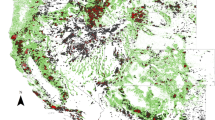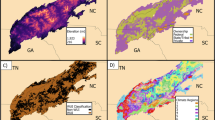Abstract
Forecasting future fire activity as a function of climate change is a step towards understanding the future state of the western mixedwood boreal ecosystem. We developed five annual weather indices based on the Daily Severity Rating (DSR) of the Canadian Forest Fire Weather Index System and estimated their relationship with annual, empirical counts of lightning fire initiation for 588 landscapes in the mixedwood boreal forest in central-eastern Alberta, Canada from data collected between 1983 and 2001 using zero-inflated negative binomial regression models. Two indices contributed to a parsimonious model of initiation; these were Seasonal Severity Rating (SSR), and DSR-sequence count. We used parameter estimates from this model to predict lightning fire initiation under weather conditions predicted in 1 × CO2 (1975–1985), 2 × CO2 (2040–2049) and 3 × CO2 (2080–2089) conditions simulated by the Canadian Regional Climate Model (CRCM). We combined predicted initiation rates for these conditions with existing empirical estimates of the number of fire initiations that grow to be large fires (fire escapes) and the fire size distribution for the region, to predict the annual area burned by lightning-caused fires in each of the three climate conditions. We illustrated a 1.5-fold and 1.8-fold increase of lightning fire initiation by 2040–2049 and 2080–2089 relative to 1975–1985 conditions due to changes in fire weather predicted by the CRCM; these increases were calculated independent of changes in lightning activity. Our simulations suggested that weather-mediated increases in initiation frequency could correspond to a substantial increase in future area burned with 1.9-fold and 2.6-fold increases in area burned in 2040–2049 and 2080–2089 relative to 1975–1985 conditions, respectively. We did not include any biotic effects in these estimates, though future patterns of initiation and fire growth will be regulated not only by weather, but also by vegetation and fire management.
Similar content being viewed by others
References
Anderson K, Englefield P (2001) Quantile characteristics of forest fires in Saskatchewan. In: Proceedings of the fourth symposium on fire and forest meteorology. American Meteorological Society, Boston, MA
Arienti MC (2006a) Natural and anthropogenic influences on fire suppression in the boreal mixedwood forest. Can J For Res 36:3155–3166
Arienti MC (2006b) The effect of anthropogenic linear features on forest fire ignition and initial suppression in northeastern Alberta. Dissertation, University of Alberta
Bergeron Y, Gauthier S, Flannigan M, Kafka V (2004) Fire regimes at the transition between mixedwood and coniferous boreal forest in northwestern Quebec. Ecology 85:1916–1932
Cameron AC, Trivedi PK (1998) Regression analysis of count data. Cambridge University Press, Cambridge
Clark JS (1998) Why trees migrate so fast: confronting theory with dispersal biology and the paleorecord. Am Nat 152:204–224
Cumming SG (1997) Landscape dynamics of the boreal mixedwood forest. Dissertation, University of British Columbia
Cumming SG (2001a) A parametric model of the fire-size distribution. Can J For Res 31:1297–1303
Cumming SG (2001b) Forest type and wildfire in the Alberta boreal mixedwood: what do fires burn? Ecol Appl 11:97–110
Cumming SG (2005) Effective fire suppression in boreal forests. Can J For Res 35:772–786
Efron B, Tibshirani RJ (1998) An introduction to the bootstrap. Chapman and Hall, New York
ESRI (2005) ArcGIS 9. Redlands, CA
Flannigan MD, Harrington JB (1988) A study of the relation of meteorological variables to monthly provincial area burned by wildfire in Canada (1953–80). J Appl Meteorol 27:441–452
Flannigan MD, Van Wagner CE (1991) Climate change and wildfire in Canada. Can J For Res 21:66–72
Flannigan MD, Bergeron Y, Engelmark O, Wotton BM (1998) Future wildfire in circumboreal forests in relation to global warming. J Veg Sci 9:469–476
Flannigan MD, Logan KA, Amiro BD, Skinner WR, Stocks BJ (2005) Future area burned in Canada. Clim Change 72:1–16
Forestry Canada Fire Danger Group (1992) Development and structure of the canadian forest fire behavior prediction system. Forestry Canada Information Report ST-X-3, Ottawa
Fried JS, Torn MS, Mills E (2004) The impact of climate change on wildfire severity: a regional forecast for northern California. Clim Change 64:169–191
Greene DF, Johnson EA (1999) Modelling recruitment of Populus tremuloides, Pinus banksiana, and Picea mariana following fire in the mixedwood boreal forest. Can J For Res 29:462–473
Hély C, Flannigan MD, Bergeron Y, McRae D (2001) Role of vegetation and weather on fire behaviour in the Canadian mixedwood boreal forest using two fire behaviour prediction systems. Can J For Res 31:430–441
Historical Wildfire Database (2005) Alberta Sustainable Resource Development, Alberta Government. http://www.srd.gov.ab.ca/wildfires/fpd/wi_hdhwd.cfm. Cited 3 Aug. 2005
Hogg EH, Wein RW (2005) Impacts of drought on forest growth and regeneration following fire in southwestern Yukon, Canada. Can J For Res 35:2141–2150
IPCC (2001) Climate Change 2001: The scientific basis. Contribution ofWorking Group I to the third assessment report of the intergovernmental panel on Climate Change. In: Houghton JT, Ding Y, Griggs DJ, Noguer M, van der Linden PJ, Dai X, Maskell K, Johnson CA (eds) Cambridge University Press, Cambridge, United Kingdom
Jasinski JPP, Payette S (2005) The creation of alternative stable states in the southern boreal forest, Quebec, Canada. Ecol Monogr 75:561–583
Johnson EA, Miyanishi K, Bridge SRJ (2001) Wildfire regime in the boreal forest and the idea of suppression and fuel buildup. Conserv Biol 15:1554–1557
Johnstone JF, Chapin FS (2003) Non-equilibrium succession dynamics indicate continued northern migration of lodgepole line. Glob Chang Biol 9:1401–1409
Johnstone JF, Chapin FS (2006) Fire interval effects on successional trajectory in boreal forests of northwest Canada. Ecosystems 9:268–277
Krawchuk MA (2007) Biophysical regulation of wildfire in the mixedwood boreal forest in the context of climate change and forest management. Dissertation, University of Alberta
Krawchuk MA, Cumming SG, Flannigan MD, Wein RW (2006) Biotic and abiotic regulation of lightning fire initiation in the mixedwood boreal forest. Ecology 87:458–468
Lambert D (1992) Zero-inflated Poisson regression, with an application to defects in manufacturing. Technometrics 34:1–14
Laprise R, Caya D, Giguere M, Bergeron G, Boer GJ, Mcfarlane NA (1998) Climate and climate change in western Canada as simulated by the Canadian Regional Climate Model. Atmos-Ocean 36:119–167
McIntire EJB, Duchesneau R, Kimmins JP (2005) Seed and bud legacies interact with varying fire regimes to drive long-term dynamics of boreal forest communities. Can J For Res 35:2765–2773
Overpeck JT, Rind D, Goldberg R (1990) Climate-induced changes in forest disturbance and vegetation. Nature 343:51–53
Paine RT, Levin SA (1981) Inter-tidal landscapes—disturbance and the dynamics of pattern. Ecol Monogr 51:145–178
Paine RT, Tegner MJ, Johnson EA (1998) Compounded perturbations yield ecological surprises. Ecosystems 1:535–545
Parisien MA, Hirsch K, Kafka V, Todd BJ, Flynn N, Flannigan MD (2005) Fire behavior potential in central Saskatchewan under predicted climate change. Prairie Adaptation Research Collaborative Document no. 05–01
Pickett STA, White PS (1985) The ecology of natural disturbance and patch dynamics. Academic, San Diego, CA
Price C, Rind D (1994) The impact of a 2x-CO2 climate on lightning-caused fires. J Climate 7:1484–1494
R Development Core Team (2005) R: a language and environment for statistical computing. R Foundation for Statistical Computing, Vienna, Austria
Rowe JS (1972) Forest Regions of Canada. Publication Number 1300. Canadian Forest Service, Ottawa, Ontario, Canada
Schoennagel T, Veblen TT, Romme WH (2004) The interaction of fire, fuels, and climate across Rocky Mountain forests. Bioscience 54:661–676
Stephens PA, Buskirk SW, Hayward GD, Del Rio CM (2005) Information theory and hypothesis testing: a call for pluralism. J Appl Ecol 42:4–12
Stocks BJ, Mason JA, Todd JB, Bosch EM, Wotton BM, Amiro BD, Flannigan MD, Hirsch KG, Logan KA, Martell DL, Skinner WR (2002) Large forest fires in Canada, 1959–1997. J Geophys Res Atmos 107:1–12
Strong WL, Leggat KR (1992) Ecoregions of Alberta. Alberta Forestry, Lands, and Wildlife, Land Information Division, Resource Information Branch, Edmonton, Alberta
Tymstra C, Flannigan MD, Armitage OB, Logan K (2007) Impact of climate change on area burned in Alberta’s boreal forest. Int J Wildland Fire 16:153–160
Van Wagner CE (1987) Development and structure of the Canadian Forest Fire Weather Index System. Forestry Technical Resport 35. Canadian Forestry Service, Ottawa, Canada
Weber MG, Flannigan MD (1997) Canadian boreal forest ecosystem structure and function in a changing climate: impact on fire regimes. Environ Rev 5:145–166
Weber MG, Stocks BJ (1998) Forest fires and sustainability in the boreal forests of Canada. Ambio 27:545–550
Wotton BM (2001) Current and future forest fire occurrence and severity in Canada: creation and validation of scenarios developed using the Regional Climate Model. Climate Change Action Fund Report S99-15-04.
Wotton BM, Flannigan MD (1993) Length of the fire season in a changing climate. For Chron 69:187–192
Author information
Authors and Affiliations
Corresponding author
Rights and permissions
About this article
Cite this article
Krawchuk, M.A., Cumming, S.G. & Flannigan, M.D. Predicted changes in fire weather suggest increases in lightning fire initiation and future area burned in the mixedwood boreal forest. Climatic Change 92, 83–97 (2009). https://doi.org/10.1007/s10584-008-9460-7
Received:
Accepted:
Published:
Issue Date:
DOI: https://doi.org/10.1007/s10584-008-9460-7




